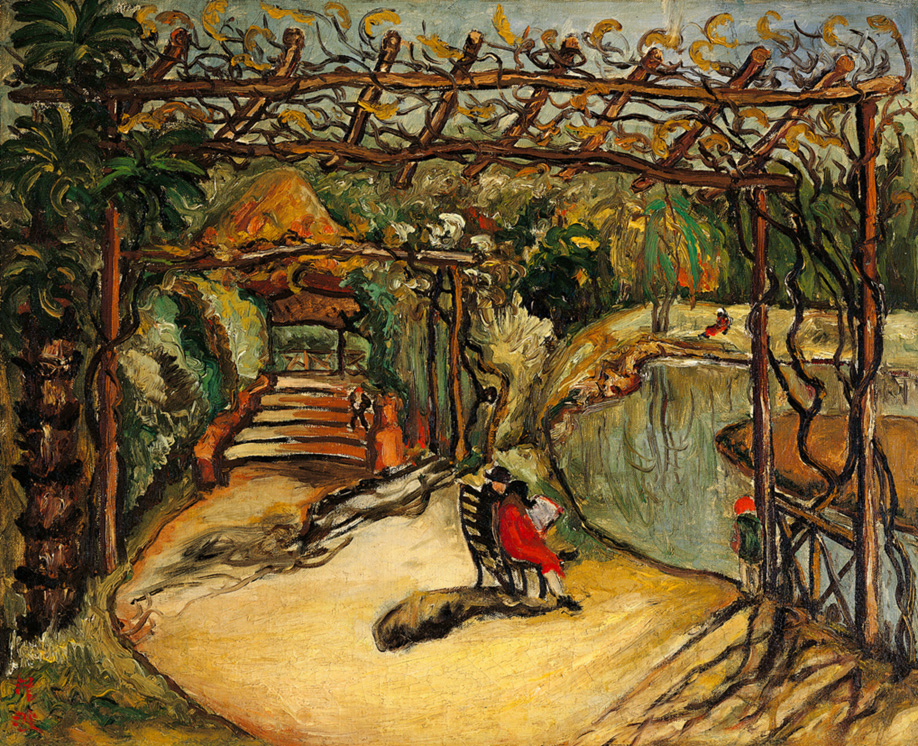Chen Cheng-po was the first Taiwanese Western Painter to be selected for Japan's Imperial Fine Arts Exhibition. With landscape paintings of his hometown, he won the highest accolades from the art scenes of Japan and Taiwan during that period, symbolizing the affirmation of his work. From then onwards, Chen Cheng-po concentrated on painting landscapes with his simple yet humorous painting style and became one of the leaders of Western style painting in the history of early Taiwanese
art. He was the first painter introduced in Taiwan Fine Arts Series and he was also the only painter amongst 31 influential personalities Filmed by Public Television Service in the Year of 2003 "A Century of Out-standing People in Taiwan".
Chen Cheng-po was born during the Ching Dynasty, in the same year when Taiwan was ceded to Japan (1895). Inside his concepts of thinking, he was proud of his father being an Imperial scholar and he knew about and adored the traditions of Chinese scholars, and was receptive and tolerant towards the different cultures of China, Taiwan and Japan. Due to his cheerful and passionate nature, his paintings were brimful of joy and happiness.
The cultivation of his art started relatively late, but prior to learning western art, Chen Cheng-po had already been nurtured m the influences of Sinology and calligraphy. In 1913, he began receiving instruction from the Japanese watercolorist, Kinichiro Ishikawa (1871-1945)and gained the dimentary knowledge about west art. He was then already 19 years of age and at the age of 30 years; he overcame the hardships in lift to gain admission into the Tokyo Fine Arts School. This, as a result, made him put in a greater and more unremitting efforts in a wholehearted wish to achieve some accomplishments in the field of painting and saw him being selected into the highly competitive Imperial Fine Arts Exhibition for four times.
Current1y, al1records show that Chen Cheng-po's earliest works was in 1924. According to the article by Madam Yen Chuan-ying, A Courageous Painter- Chen Cheng-po, we broadly categorized the paintings in his lifetime of creation into three stages: "The Tokyo Period" (1924-1929), "The Shanghai Period" (1929-1933) as well as "The Return to Native Soil Period" (1933-1947).
In the first stage of "The Tokyo Period", Chen Cheng-po adhered to an institutional style of training while pursuing self-exploration as well. Influenced by the Post-Impressionist, Vincent van Gogh, his painting style include towards the bubbling passion and enthusiasm found in Fauvism. During the second stage of "The Shanghai Period", he became a teacher of western style painting in an art school. Overcame with admiration for masters of Chinese ink and wash painting, the manner of his painting explorations in this period was a combination of both the Chinese and Western style, infusing with the energetic lines alike those of Ni Yun-lin (1306-1374), a painter cum calligrapher in the Yuan Dynasty, as well the texturing method and brushing (touch) technique of Ching Dynasty's Pa-ta-shan-jen (Chu Ta, 1624/1626-1705), and pursuing moods containing eastern appeals of China as well as developing his "reverse perspective" concept pf composition in a more wanton, self - willed manner. However, coupled with the sanguine and lively disposition of tropical southerners, he formulated a strange yet fascinating, simple yet unique painting style. In "The Return to Native Soil Period", that developed upon returning to Taiwan in 1933, Chen Cheng-po visited and observed the local customs and conditions in all of Taiwan. Completing his landscape paintings of such places as Tamsui and Chiayi, another peak was created in the artist's painting career.
Madam Lin Yu-chun pointed out for, Paint-Passion-Chen Cheng-po, the book published by Hsiung Shih, that the 1930s was the peak for Chen Cheng-po's personal painting creations and it was also a flourishing period of development for the whole
of Taiwanese Art. She believed that Chen Cheng-po's progressive and passionate disposition was the very the reason why Chen Cheng-po was able to continuously overcome every sort of obstacle, whether tangible or otherwise, and keep true to the implementation of his self-ideals. Chen Cheng-po was not merely the first Taiwanese painter to be admitted into the most authoritative Imperial Fine Arts Exhibition, he was also the Taiwanese painter in the 1930s to come away with accomplishments in exchanges to Mainland China. Besides this, his non-yielding, non-forsaking romantic sentiments and the distinctive Taiwanese local features that he discovered wholeheartedly were aspects most admired of him by others.
"French Park, Shanghai" was created in 1933, which mixing the art of Chinese and Western. In this picture, Chen used the line of landscape painting massively. The hues and intensity of reflection, brushwood and vine are accordance. He drew and expressed harmony in every part, it exist technique of outline and sprinkle which came from the Chinese writing brush. Not only the branch could express by line, even the ladders, characters, lights and shades are all through the line performance. This painting could be regarded as one of mature works in this period.
